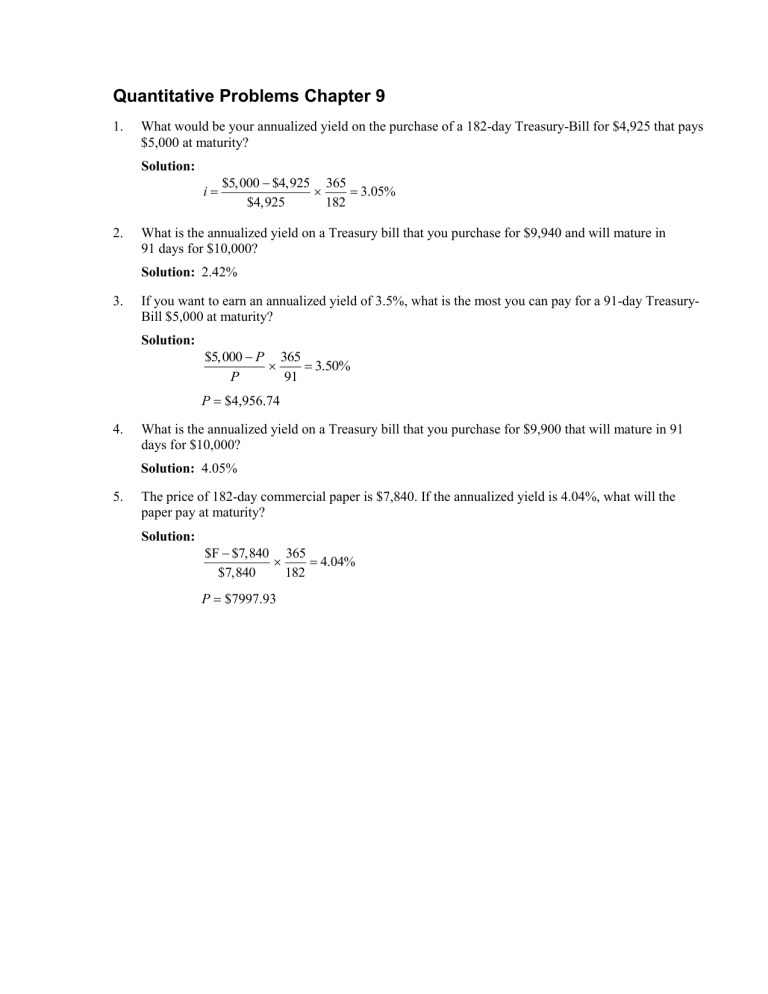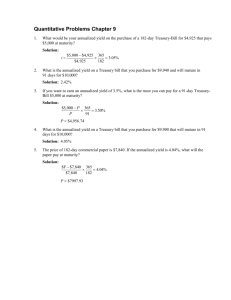
Quantitative Problems Chapter 9 1. What would be your annualized yield on the purchase of a 182-day Treasury-Bill for $4,925 that pays $5,000 at maturity? Solution: i 2. $5,000 $4,925 365 3.05% $4,925 182 What is the annualized yield on a Treasury bill that you purchase for $9,940 and will mature in 91 days for $10,000? Solution: 2.42% 3. If you want to earn an annualized yield of 3.5%, what is the most you can pay for a 91-day TreasuryBill $5,000 at maturity? Solution: $5,000 P 365 3.50% P 91 P $4,956.74 4. What is the annualized yield on a Treasury bill that you purchase for $9,900 that will mature in 91 days for $10,000? Solution: 4.05% 5. The price of 182-day commercial paper is $7,840. If the annualized yield is 4.04%, what will the paper pay at maturity? Solution: $F $7,840 365 4.04% $7,840 182 P $7997.93 6. How much would you pay for a Treasury bill that matures in one year and pays $10,000 if you require a 1.8% return? Solution: $9,823.18 7. The price of $8,000 face value commercial paper is $7,930. if the annualized yield is 4%, when will the paper mature? Solution: $8,000 $7,930 365 4.00% $7,930 X X 80 days 8. How much would you pay for a Treasury bill that matures in one year and pays $10,000 if you require a 3% return? Solution: $9,708.74 9. The annualized yield on a particular money market instrument is 3.75%. The face value is $200,000 and it matures in 51 days. What is it’s price? What would be the price if it had 71 days to maturity? Solution: $200,000 P 365 3.75% P 51 P $198,958 $200,000 P 365 3.75% P 71 P $198,552 10. The annualized yield is 3% for 91-day commercial paper and 3.5% for 182-days commercial paper. What is the expected 91-day commercial paper rate 91 days from now? Assuming the difference is just due to higher future interest rates, an investor should be able to earn the same return over 182 days using either 182-day paper or a 91-day paper rollover strategy. Assume that the 182-day paper has a $100,000 face value. The current price is: $100,000 P 365 3.5% P 182 P $98,284.73 Now, invest the same amount in 91-day paper. F 98,284.73 365 3.0% 98,284.73 91 F $99,019.87. That is, such an investment should payoff $99,019.87 after 91 days. Now, invest $99,019.87 in 91-day paper again. It is expected to give a final value of $100,000 (just like the 182-day paper). 100,000 99,019.87 365 3.97%. The 91-day rate in 91-days is expected to be 3.97%. 99,019.87 91 11. Assume that 45% of a Treasury Bill auction was sold for $998 per $1,000 per value, 35% was sold for $997, and the last 20% was sold for $996. What would be the weighted average price paid by a noncompetitive bid? Solution: $998 0.45 $997 0.35 $996 0.20 $997.25 Noncompetitive bidders pay $997.25 per $1,000 of Treasury Bills purchased. 12. In a Treasury auction of $2.5 billion par value 91-day T-bills, the following bids were submitted: Bidder 1 2 3 4 5 Bid Amount $500 million $750 million $1.5 billion $1 billion $600 million Price $0.9940 $0.9901 $0.9925 $0.9936 $0.9939 (a) If only these competitive bids are received, who will receive T-bills, what quantity, and at what price? (b) If the Treasury also received $750 million in noncompetitive bids, who will receive T-bills, what quantity, and at what price? Solution: (a) If only the competitive bids are received, the following bids, quantities, and prices will be awarded: Bidder 1 5 4 3 Bid Amount $500 million $600 million $1 billion $400 million Price $0.9940 $0.9939 $0.9936 $0.9925 Amount Paid $497.00 million $596.34 million $993.60 million $397.00 million (b) If $750 million in noncompetitive bids are also received, the following bids, quantities, and prices will be awarded: Bidder 1 5 4 Competitive Bids Bid Amount Price $500 million $0.9940 $600 million $0.9939 $650 million $0.9936 Amount Paid $497.00 million $596.34 million $645.84 million Noncompetitive Bids $750 million $0.9938* $745.35 million $0.9938 (500 0.9940 600 0.9939 650 0.9936)/1,750 *


